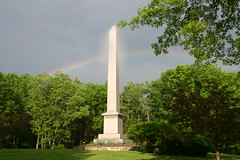Although hundreds of scattered settlements were colonized by the mormon pioneers, Salt Lake City rapidly developed into a large, thriving community. In February 1849, about four thousand people lived in the valley. This growth led to the city’s division into nineteen ecclesiastical wards (congregations).
Together these wards composed the Salt Lake Stake. This chapel is located in the Seventeenth Ward of the original Salt Lake Stake. When the Assembly Hall was first completed on Temple Square, stake meetings were held there. Today, this chapel serves as the Salt Lake Stake Center.

 The modern Salt Lake Seventeenth Ward building.
The modern Salt Lake Seventeenth Ward building.David M. Whitchurch
In early Salt Lake history, each ward was responsible to construct its own building. The first meeting place for the Seventeenth Ward was a log building located across the street south of the present building.
The Seventeenth Ward then erected a more permanent building, also situated across the street, directly southwest of this building. In 1904, when the Salt Lake Stake was divided into four separate stakes, the Seventeenth Ward remained a part of the original Salt Lake Stake.
 This window was made by Tiffany’s of New York,
This window was made by Tiffany’s of New York, producer of some of the finest stained-glass in nineteenth-century America.
James Sherman
 Detail of the stained-glass window depicting the First Vision,
Detail of the stained-glass window depicting the First Vision, in which Joseph Smith saw God the Father and His Son, Jesus Christ.
James Sherman

___________________________________________________________________
___________________________________________________________________
Brigham Young University Religious Education presents
Hallowed Ground Sacred Journeys
Featuring BYU Religious Educators teaching about sites significant in
The Church of Jesus Christ of Latter-day Saints
For more information, or to visit our interactive web site with dozens of additional sites to explore,
please visit VirtualTours.BYU.edu
Hallowed Ground Sacred Journeys
is a co-production of
This blog is a public service of The Watchmen Institute
and is distributed by B.U.M.P. LTD.
All Rights Reserved

























